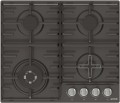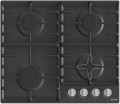Number of WOK burners (turbo)
The number of gas burners in which the flame is located not in one, as in standard burners, but in two (or three) rows — in other words, in the form of two (three) rings, one inside the other. Burners with this design have more power than conventional single-row ones and heat the bottom of the pan more evenly, which can be especially useful when frying. In addition, it is believed that such heaters are best suited for wok pans. At the same time, for most tasks, such increased power is unnecessary. Therefore, most models with this function have only one
turbo burner.
Burner grates
The material from which the grates on the gas burners of the hob are made. Electric hotplates do not require grates.
— Steel.
Steel grates have a relatively low weight, good strength and at the same time — low cost. For aesthetic reasons and for additional protection they are usually covered with a special heat-resistant enamel. Contaminants are quite easily cleaned from such enamel, but it is undesirable to process it with rough methods — otherwise, chips and scratches may appear on the surface. In general, despite their general practicality, steel grates are considered less advanced than cast iron grates and are somewhat less commonly used in hobs. However, if you do not load the hob with large pots, buckets, etc., the difference is not critical, and the service life of steel grates is often comparable to the “life span” of the hob itself.
— Cast iron.
Cast iron grates look more nice and massive than steel ones, and they weigh much more. It can be attributed to the advantages — in the case when the grilles can be removed: a large weight contributes to stability. In addition, such structures are strong, durable and tolerate even high loads. They cost a little more than steel ones. As a result, cast iron is a more popular material for grates than steel. It is worth noting some difficulty in cleaning from pollution; on the other hand, cast iron grates usually do not have additional coating
...s, and you can not be afraid to spoil them with wire sponges or abrasive products.Cut-out dimensions (WxD)
The size of the opening that needs to be made in the kitchen countertop for the normal embedding of the hob. By default, the width and depth are indicated — the size of the opening along the front and side sides, respectively (when viewed from the user's side). Note that the dimensions of the hob itself are usually larger than the dimensions for embedding: when installed in an opening, the upper part of the surface rests on its edges, so that the device does not fall into the countertop.

